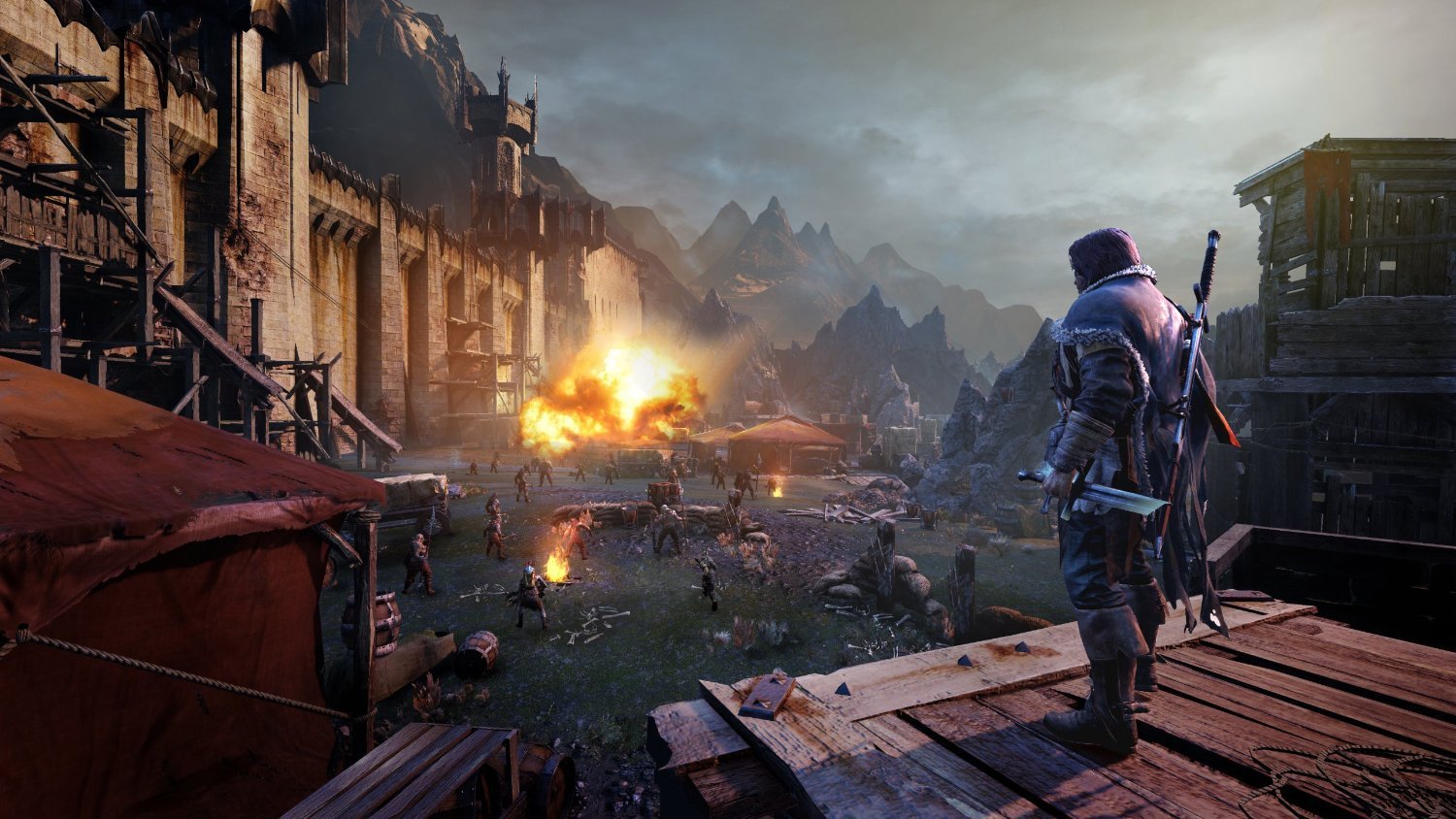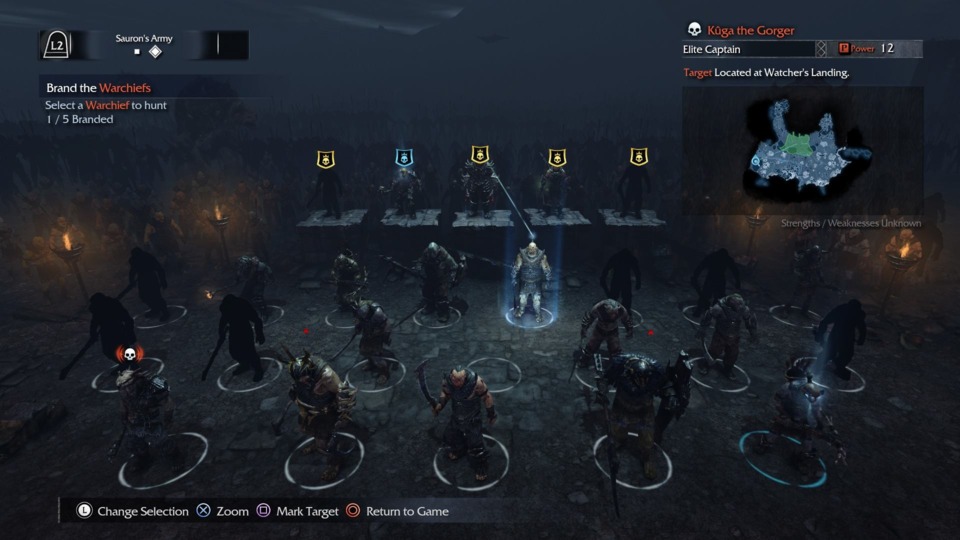
Life returns to Mordor, well, until you get your hands on them…
Ever since this title was announced, I have been unbelievably excited as, being a Tolkien fan, anything that revisits the world of Middle Earth is like all of my christmases coming at once. And unusually for many games released in the past few years, this one lives up to the hype and matches the promises made by the developers during production, making for a game that as well as being incredibly well presented, is extremely fun to play and also delivers nuggets of lore for fantasy nuts like myself. The Nemesis system is well implemented in the game, however, some may feel that the individual character of specific Orc captains fails to live up to the promises of Monolith. The general storyline is also quite straightforward, pulling heavily from tropes of a murdered family and a man seeking revenge, but if any franchise is able to use tried and tested fantasy plot devices, it’s The Lord of the Rings, as Tolkien practically invented the genre of fantasy single handedly. You play as Talion, a Gondorian Ranger, who is captain of the Black Gate which guards the approach to Mordor. Until that is, Sauron returns to his land and sends his servants to retake the Gate. The Black Hand leads the assault, with his two minions, The Tower and The Hammer, who ritually kill Talion’s wife and son, and then Talion himself. Talion does not take to death, however, soon awaking to find he is able to channel the abilities of a vengeful wraith who has apparently got a surprisingly intimate relationship with the Dark Lord, vowing to help Talion seek revenge if he can help the spirit find answers. This sets up the basic premise of the game, the combination of Talion’s desire for revenge and the quest for knowledge that they both share
Shadow of Mordor has clearly taken inspiration from other popular open-word games such as Assassins Creed and the Batman: Arkham games, but in this case it has enough of it’s own character to carry it off. The free running is implemented incredibly well, running and leaping being tied to one key and stealth to another, making combinations of both laughably easy to pull off. It is beautifully satisfying utilising combinations of both to quickly and stealthily take out a whole Orc patrol without raising the alarm, and gives a real sense of accomplishment for a job well done. This is especially fulfilling as the enemy AI is quick to spot you if you are caught in the open, meaning you have to be decisive and lightning quick to prevent being overwhelmed by enemies. When you do find yourself in combat, the game is equally able to provide an enjoyable and satisfying experience, utilising the same counter and combo system as the Batman: Arkham games, which works fantastically well. When paired with the psuedo-medieval setting of Middle Earth, involving a huge sword, the already satisfying violence of the system in a hand-to-hand setting is, in my opinion, vastly improved. The fighting animations are smooth and well-rendered making for a very pleasing aesthetic experience, which is also more friendly to the player than in the Batamn: Arkham games as counters can be executed at any time and the character does not get stuck in a particular animation. I feel that this removes a major gripe that most have with the system, making it an almost flawless way to control combat in-game.

You’ll have no problem keeping Orcs at bay with that thing!
There are a variety of ways to spend your time within Mordor, involving challenges and items to find, providing information and background to the environment of Mordor and also Middle Earth itself in a wider context. One of the ways in which your time can be spent is hunting for the various collectables that can be found hidden throughout the land, which come in two forms; the elvish ‘Ithildin’, and artifacts which reveal pieces of dialogue from the peoples who resided in Mordor in the past. For people like myself who are huge fans of the mythos, the artifacts are great fun to track down, piecing them into the wider story of Tolkein’s work, but even if this isn’t the case they are interesting and provide a nice background hum of life to Monolith’s construction of Mordor. ‘Ithildin’ on the other hand (star or moon runes) are generally a little more difficult to find and what they provide is less obvious. Discovering all of the runes hidden (normally pretty well) throughout the landscape is a good way to break up the storyline and also to just stop and appreciate how good everything looks. Collecting the runes is also a way to upgrade Talion’s abilities through the use of ‘Mirian’, a type of currency which can be used to purchase upgrades for health, wraith abilities, stealth abilities and attack upgrades. Shadow of Mordor also features a wide variety of challenges, missions and side-quests which compliment the main game and ensure that things don’t become monotonous which can sometimes be the case with open-world games (I feel Assassins Creed can often suffer from this). Weapon challenges for Talion’s sword, dagger and bow are all available offering rune upgrades for each type of weapon, depending on the challenge undertaken, which compliments the runes that are awarded for defeating Orc captains and Warlords. A smattering of rescue missions are also frequently available, in which you are given opportunities to rescue slaves in return for experience points and sometimes intelligence on Orc captains. In terms of secondary characters, there are also some interesting side-quests involving some characterful characters (yes, that makes perfect sense) such as an exiled Gondorian Ranger and a Dwarven hunter, as well as a human sorceress and a certain wretched, jewellery obsessed fellow.
One feature which Monolith has talked extensively about since Shadow of Mordor was first revealed to be in production is the Nemesis system, which was built up as being a central feature of the game, meaning you could shape events by your actions. You could have influence on the power, abilities and personality of specific Orc characters, to the extent that no two players would experience the same characters, being based on your own personal rivalries. In reality, the Nemesis system has been implemented well and you do develop a certain kind of relationship with Orc captains, some of whom you come to despise, especially on the occasions where they decide that due to your poor performance in battle you aren’t worth their time, and saunter off in disgust. You do also see your influence on them, as by the nature of your ability or inability to stop assassinations, recruitments, challenges and ambushes by other groups of Orc on a specific character that their fortunes can change; being killed or promoted, or even gaining new abilities and influence over others. This can be seen especially clearly in the way that after each successive defeat, a Captain will appear to be held together with bits of rope, bandages, rivets and metal plates. The same type of effect is also seen with promotions and increases in power, with a lowly grunt rising up the ranks, accompanied by ever more spiky, dangerous looking armour and weapons. The problem with the system is the same as the problem I have previously described with the Fable series, the promises were made, but they were too sweeping, too broad and ultimately doomed to fail due to their ambition. In this case though, the promise has been achieved to some extent, leaving a system which does make the game more immersive and enjoyable for the player.

The Nemesis system: who do you dislike the most?
Middle Earth: Shadow of Mordor is a very polished game, and one that I really, really enjoyed playing, so much so, that I still am and I think will continue to far into the future. First of all, it looks great, even given the locations the game takes place in being predominantly brown environment, and the whole of Mordor has been given an element of life due to the slave gangs and bands of roaming Orcs. Also, something I didn’t have space to mention above; the weather effects are fantastic, the rain is brilliantly realistic and changes the mood of the game impressively well. The gameplay is also streamlined, immersive and enjoyable, with well rendered animations and cogently realised mechanics for the action and stealth elements, and the combination of stealth and sword-y violence works together extremely well to produce, well, just a really, really fun player experience. The variety of in-game ‘entertainments’ is also pleasantly variable and provides enough to do for at least 20 hours of play-time (or more for those completionists among you), with enough challenge to push some players, especially on the higher difficulties. All in all, this game is one of the best I’ve played, and for me that is an impressive accolade as I always feel the majority of games are missing that elusive something. This one, is definitely the complete package, as being a game that is easy to play, but difficult to master, combined with the visuals, the mechanics, the plot, the extra Tolkien goodies and the Nemesis system, it’s just good fun to play. And after all, is that not what video-games are for?
